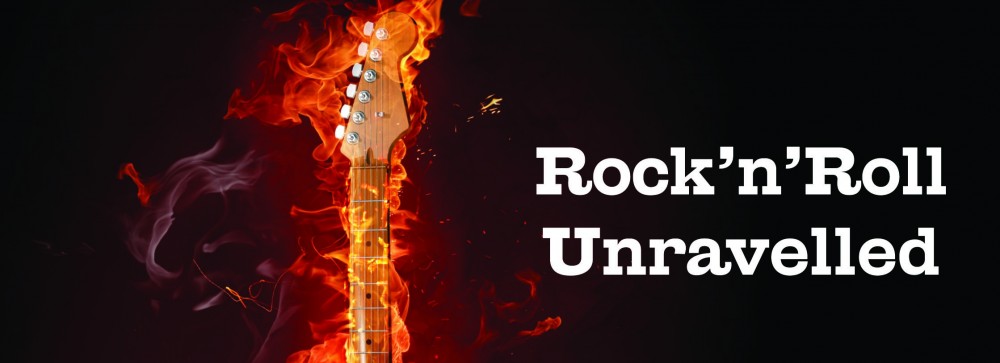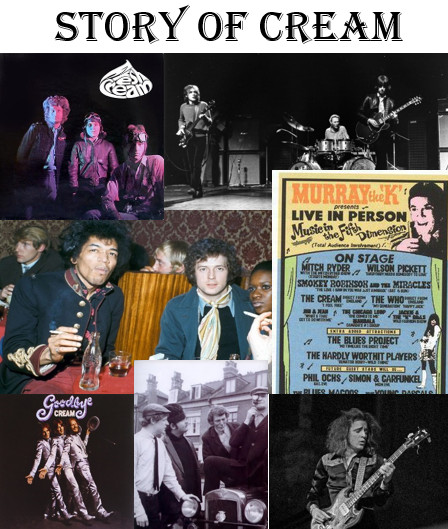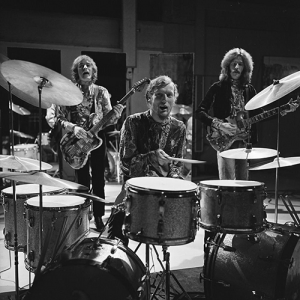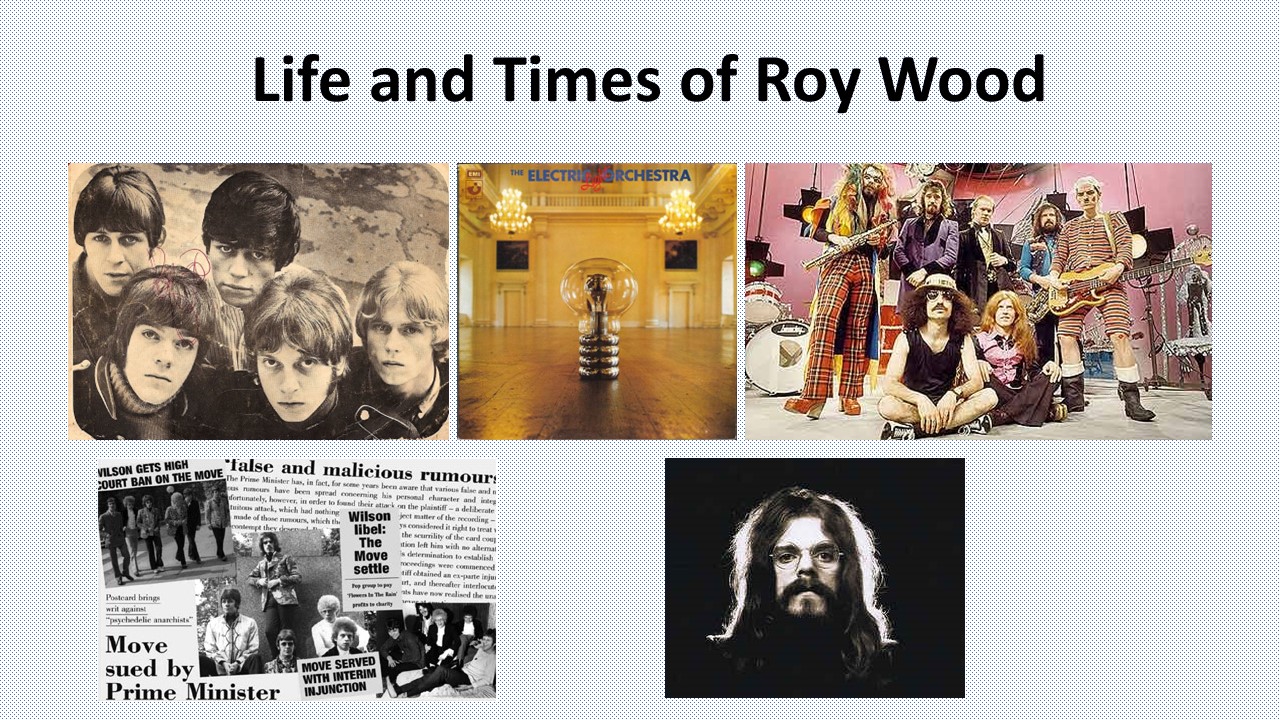THE FIRST SUPERGROUP
The first group to be have the accolade of supergroup. The story of Cream: guitarist – Eric Clapton, bassist Jack Bruce and drummer Ginger Baker – CREAM
They came to the group with some of the most impressive backgrounds in rock’n’roll history. To begin our story, we’ll look at what the lads were up to before they came together and then savour some of the highlights of Cream’s short but illustrious career.
TO PUT CREAM INTO ROCK’N’ROLL CONTEXT
When they came together in July 1966, beat music was morphing into the much harder-edged – rock music. The beat groups of the first-half of the 1960s were fading away. The ones who continued to find success tended to be the bands who wrote their own material, such as the Beatles, the Rolling Stones and the Kinks.
The British Invasion, 1964 to 1966 was a time when British acts dominated American music scene. It was led by the Beatles, who had 31 Billboard Top-40 hits, across this period, including 12 #1s and the Rolling Stones, who scored 13 Billboard Top-40 hits, three of which were #1s. It’s interesting to note that we looked at how Merseybeat bands dominated the first wave of the British Invasion. Check out the story of how Merseybeat Bands led the British Invasion
Times were certainly a-changin’…
In the UK:
At the end 1965, the Who were lamenting the desire in My Generation to, die before I get old.
The Move formed at the beginning of 1966.
Pink Floyd were getting underway, releasing their first single in early 1967.
In America:
On the East Coast…
The Velvet Underground had their first gig with lead singer Nico at the beginning of 1966.
On the West Coast…
Grateful Dead changed their name from “The Warlocks” in late 1965.
The 13th Floor Elevators received a review describing them as psychedelic in February 1966. One of the first references to as band as “psychedelic”.
The Doors started their residency at LA’s Whiskey A-Go-Go in May 1966 and signed to Elektra in August.
Cream were at the vanguard of the new rock music. Some of the new bands were experimenting with psychedelic rock but Cream were firmly based in the blues. Although, they did venture into psychedelia on their second album, Disraeli Gears.
ERIC CLAPTON
30 March 1945: Eric Clapton was born in Ripley, Surrey.
January 1963: Eric Clapton joined the Roosters. The band also included: Tom McGuinness and Ben Palmer. Rolling Stones founder, Brian Jones occasionally sat in with the Roosters.
September/October: The Roosters folded, Eric Clapton and Tom McGuinness joined Casey Jones and the Engineers. Casey Jones was Liverpool’s Brian Casser, founder of Merseybeat band Cass and the Cassanovas. Eric Clapton’s stay in the band was very brief. He was around for about seven gigs before deciding that the band was too pop orientated for his taste. He left to join the Yardbirds. Tom McGuinness left in early 1964 to join Manfred Mann, just as they were achieving success with 5-4-3-2-1.
THE YARDBIRDS
October 1963: Eric Clapton replaced original guitarist Top Topham in the Yardbirds. Top Topham was only around 16 years old, when growing local fame meant that the Yardbirds decided to turn professional. The other members of the band were a little bit older than Topham. His parents were against him becoming a professional musician. He quit the group in order to continue his studies.
7 & 8 December: The Yardbirds had recently taken over from the Rolling Stones as house band at the Crawdaddy club in Richmond, London. Both nights’ performances were recorded by their manager Giorgio Gomelsky. The second night was with blues legend Sonny Boy Williamson (II). This resulted in the album, Sonny Boy Williamson & The Yardbirds, which was released a couple of years later.
February 1964: Demo recording session at RG Jones studio in Morden, London. The session was produced by Mike Vernon, who founded the Blue Horizon record label.
6 February: The Yardbirds started their residency at the Marquee club in London. Manager Giorgio Gomelsky knew Harold Pendleton, Marquee owner, from previous associations. Giorgio Gomelsky was one of the prime movers on the London R&B scene, as well as being the Yardbirds manager, he produced their recordings. He was also the Rolling Stones first manager, until Andrew Loog Oldham saw them at the Marquee and signed them up. In 1966 he formed his own record label, Marmalade.
end October: The Yardbirds released their second single, Good Morning Little Schoolgirl. It was their first UK hit single, peaking at #44.
December: Released their first UK album, Five Live Yardbirds, recorded at London’s Marquee club on 13 March 1964.
March 1965: Eric Clapton played his final gig with the Yardbirds.
5 March: Yardbirds released their third UK single, For Your Love c/w Got to Hurry. This was the last single to feature Eric Clapton. For Your Love was written by Graham Gouldman. The writing credit for the B-side, Got to Hurry, was given to “O. Rasputin”, a pseudonym for Giorgio Gomelsky. The band credit on label appears as, “Yardbirds featuring Eric “Slowhand” Clapton”.
Once again, the band became too pop-orientated for blues enthusiast Eric Clapton and he moved on to join John Mayall’s Bluesbreakers. Jeff Beck replaced his as lead guitarist in the Yardbirds.
JOHN MAYALL’S BLURSBREAKERS
Summer: Not long after he joined John Mayall’s Bluesbreakers, Eric Clapton decided to take a sabbatical and formed his own band, the Glands. This was a loose collection of musicians, which included pianist Ben Palmer, formerly with Clapton in the Roosters. The plan was to play their way across Europe and beyond. The journey only took them as far as Greece, where they were blackmailed by a club owner for working without permits. Trapped into playing for this club owner, they finally managed to make their escape but Clapton lost his amp in the process.
September 1965: Jack Bruce joined John Mayall’s Bluesbreakers. He was still with the band when Eric Clapton returned from Greece.
October: John Mayall’s Bluesbreakers released I’m Your Witchdoctor. It featured Eric Clapton and was produced by Jimmy Page. Andrew Loog Oldham released the single on his Immediate record label.
early November: Eric Clapton returned from Greece and rejoined John Mayall’s Bluesbreakers. He replaced guitarist Peter Green, who had only joined the band a week earlier. The lineup now was: John Mayall, Eric Clapton, Jack Bruce and drummer Hughie Flint. Clapton played alongside Jack Bruce for the first time. Bruce left the band shortly after Clapton rejoined and moved to Manfred Mann.
ERIC CLAPTON AND THE POWERHOUSE
mid-1966: Released the American, Various Artists album – What’s Shakin’, also released in the UK as Good Time Music. Eric Clapton and the Powerhouse contributed three tracks to this Elektra album. It was a one-off studio project but there are references to gigs by the band.
The Powerhouse was another “supergroup”. As well as Eric Clapton from John Mayall’s Bluesbreakers, the lineup boasted: Ben Palmer piano, previously with Clapton in the Roosters and the Glands, Jack Bruce and Paul Jones (harmonica) from Manfred Mann; and Pete York (drums) and Stevie Winwood (vocals) from the Spencer Davis Group. For contractual reasons, Winwood was billed as “Steve Anglo”.
Three tracks:
Steppin’ Out – popularised by Memphis Slim in the late 1950s
I Want to Know – writing credit to Shelia MacLeod, who was married to Paul Jones at the time.
Crossroads – written and originally recorded by Robert Johnson as Cross Road Blues in 1936. Covered by Cream, as Crossroads, on their 1968 album Wheels of Fire.
22 July 1966: John Mayall released Bluesbreakers with Eric Clapton in the UK. Produced by Mike Vernon, the lineup comprised Eric Clapton, Hughie Flint, John McVie and John Mayall. Eric Clapton left the Bluesbreakers to form Cream around about the same time as the album was released.
Peter Green replaced Eric Clapton in the Bluesbreakers – for the second time.
JACK BRUCE + GINGER BAKER
The paths of these two artists criss-cross on their individual roads to Cream.
JACK BRUCE
14 May 1943: Jack Bruce was born in Bishopbriggs, Lanarkshire, Scotland. He learnt cello and musical composition at early age.
late 1950s/early 1960s: Jack Bruce played double bass with the Murray Campbell Big Band. (double bass is another term for the upright bass)
1962: Moved to London and joined Alexis Korner’s Blues Incorporated.
There is a great photo showing a mid-1962 lineup with: Dave Stevens – piano, Dick Heckstall-Smith – sax, Alexis Korner – guitar, Jack Bruce – double bass, Mick Jagger – vocals and Cyril Davies – harmonica. The drummer is not visible in the photo but it was probably future-Rolling Stone Charlie Watts.
GINGER BAKER
19 August 1939: Ginger Baker was born in Lewisham, London. In his early days he made his own drum kit by bending Perspex into cylinders over his gas stove. Urban legend has it that his kit met its end during one of Baker’s onstage bust-ups with Jack Bruce. Ginger Baker pioneered the use of the double bass-drum kit and led the way to extended drum solos, with his epic solo Toad.
1956: Ginger Baker joined the Storyville Jazzmen and was later with Terry Lightfoot’s jazz band.
early 1963: Ginger Baker joined Alexis Korner’s Blues Incorporated to replace Charlie Watts, who had moved on to join the Rolling Stones in January 1963. The lineup included: Ginger Baker, Jack Bruce, Graham Bond and Dick Heckstall-Smith.
GRAHAM BOND ORGANISATION
February: Ginger Baker, Graham Bond and Jack Bruce left Alexis Korner’s Blues Incorporated to form the Graham Bond Trio. As the story goes… Bond approached Alexis Korner and told him that the three of them were leaving. The first that Baker and Bruce knew of this was when they found that they had parted company with Korner and were now, the Graham Bond Trio.
20 February: Duffy Power recorded: I Saw Her Standing There – written by Lennon and McCartney. Power was backed by the Graham Bond Quartet. They recorded two versions of the song. The first with Graham Bond, Jack Bruce, Ginger Baker and future Mahavishnu Orchestra guitarist and founding member John McLaughlin. They were back in the studio again on 20 March, to record a second version. McLaughlin was unavailable, his place was taken by session guitarist Big Jim Sullivan.
The song was coupled with Graham Bond’s composition Farewell Baby. It was released in May as Duffy Power’s eighth UK single. He was another 1960s artist who received tremendous critical acclaim but very little commercial success.
January 1965: Graham Bond Organisation backed Chuck Berry on his UK Tour.
JACK BRUCE – JOHN MAYALL & MANFRED MANN
September: Jack Bruce left the Graham Bond Organisation, sacked after several arguments with Ginger Baker. Undaunted, he continued to turn up for gigs, until Ginger Baker pulled a knife on him and suggested… enough was enough.
September 1965: Jack Bruce joined John Mayall’s Bluesbreakers and was in the band when Eric Clapton returned from Greece. He moved on shortly after Clapton’s reinstatement.
22 November: First gig with Manfred Mann
April 1966: Manfred Mann released Pretty Flamingo, Paul Jones’s swan song as lead singer and the only single with Jack Bruce on bass.
26 June: Jack Bruce’s last gig with Manfred Mann. He left to form Cream.
GINGER BAKER – GRAHAM BOND ORGANISATION
14 March 1966: The Who – released Substitute c/w Waltz for a Pig.
Substitute was released with three different B-sides. It was the Who’s follow-up to My Generation and their first release on the new Reaction label.
Two versions of Substitute were released with the Pete Townshend penned B-sides Circles and Instant Party. In reality they were both the same song.
Shel Talmy produced their previous recordings at Brunswick. Whilst the Who were there, they had already recorded a version of Instant Party. Shel Talmy took a very dim view of the Who re-recording the song for their new label. To make his point, he released his Brunswick version of Instant Party as the B-side of A Legal Matter.
He also obtained an injunction which stopped sales of Substitute and prevented the Who from recording. Rather than have sales of Substitute stall, the Who released a third version of the single with a new B-side – Waltz for a Pig.
This new B-side had an artist credit for the Who Orchestra and a writing credit for Harry Butcher. The Who Orchestra was in fact the Graham Bond Organisation, with a lineup which included Graham Bond and Ginger Baker. “Harry Butcher” was non-other than Ginger Baker.
Mid-1966: Ginger Baker left the Graham Bond Organisation to form Cream.
HOW THEY CAME TOGETHER AS CREAM
Eric Clapton sat in on a Graham Bond Organisation gig, with Ginger Baker, at the Flamingo in London. Ginger Baker rated Eric Clapton.
May/June 1966: Ginger Baker returned the compliment and sat in with Eric Clapton at a John Mayall’s Bluesbreakers gig in Oxford.
Following this, Ginger Baker asked Eric Clapton if he fancied starting a band. Eric agreed. He had played with Jack Bruce in John Mayall’s Bluesbreakers after returning from his summer jaunt in Greece and insisted that Bruce joined them. Clapton had no idea of the volatile history between Bruce and Baker.
July: Cream played a warm-up gig at the Twisted Wheel in Manchester.
31 July: The official debut concert at 6th National Jazz and Blues Festival in Windsor. Georgie Fame, The Action and Alan Bown were on the same bill
1 October: Jimi Hendrix jammed with Cream at a Central London Polytechnic gig supported by the Washington DC’s.
The Animals had recently split up following their final American tour. Bass player Chas Chandler had a change of direction and became Jimmy Hendrix’s manager. He persuaded him to change his name from “Jimmy” to “Jimi” and move to the UK to start a band.
Chandler introduced Hendrix to Eric Clapton and he jammed on stage with Cream. They played Killing Floor, a Howlin’ Wolf single from 1965. Urban legend has it that Clapton so dismayed afterwards because of Hendrix’s prowess, that he nearly packed it all in.
October: Released their first single, Wrapping Paper c/w Cat’s Squirrel. Jack Bruce and lyricist Pete Brown wrote Wrapping Paper. They subsequently wrote most of the original material performed by Cream. Robert Stigwood produced the single. The B-side writing credit went to “Trad. Arr. S, Splurge”, where S. Splurge was a pseudonym for the band, Eric Clapton, Jack Bruce and Ginger Baker.
It gave them a UK hit, peaking at #34.
9 December: Released their first UK album, Fresh Cream. Once again produced by their manager, Robert Stigwood. This gave them a top-10 album, peaking at #6.
9 December: Released I Feel Free, another UK hit peaking at #11.
January 1967: Released I Feel Free as their first American single, on the Atco label. Despite being a hit in the UK, it failed to make an impression on the American charts.
CREAM OPENED IN AMERICA
25 March: Opened in America, billed as “direct from England”, on DJ Murray the “K”’s Live in Person, Music in the Fifth Dimension, package show. This was nine consecutive days of five shows a day, at New York’s RKO Theatre. The multiple acts included: The Who, Wilson Pickett, Smokey Robinson and the Miracles, Mitch Ryder, and The Blues Project. Murray the “K”’s wife and dancers performed as, Jackie and the “K” Girls. The poorly attended shows were chaotic, with very short performances. Some of the acts didn’t even bother to turn up.
The Who gave storming performances, with a crowd-pleasing demolition of their equipment five-times a day. They were unknown in America at this time but cracked America at Monterey, a couple of months later.
2 April: The shows ended. The following day the band were in Atlantic Records’ New York studios to begin recording their second album, Disraeli Gears.
2 November: Released their second UK album, Disraeli Gears. Felix Pappalardi was the producer. It was released in America one month later.
The album is an acclaimed psychedelic album, including Sunshine of Your Love written: Jack Bruce, Pete Brown and Eric Clapton.
7 Mar 1968: Recorded Toad, for the Wheels of Fire album, at the Fillmore West, San Francisco.
Drum solos…
Drum solos were rarely found in rock’n’roll and beat music. However, they were a standard feature with jazz and big bands. Fans of these genres were often treated to stunning percussion displays from drummers such as: Louie Bellson, Elvin Jones, Gene Krupa and Buddy Rich.
Sandy Nelson was probably the first pop music drum-hero. He scored a Top-10 on both sides of Pond with Teen Beat in 1959.
The Who’s Keith Moon and Jimi Hendrix’s Mitch Mitchell did much to establish the prominence of drummers in rock bands.
Ginger Baker led the way with the double bass-drum kit and extended drum-solos, much loved by later prog and hard rock bands.
THE BEGINNING OF THE END
May: Halfway through their second American tour, almost exactly two years after they came together, Cream made the decision to spit up.
Some of the factors included: resentment over royalties and composer credits; increasing volumes, Jack Bruce developed tinnitus; and clashing egos onstage.
Eric Clapton…
Clapton’s values were changing. After listening to The Band’s Basement Tapes and Music from the Big Pink he wanted a subtler sound. He was also becoming tired of having to be the guitar hero for the fans, seeking something less pressured.
Jack Bruce
Bruce put the end down to a really bad review in Rolling Stone magazine in May 1968. The review hit the group’s confidence. Bruce was becoming bored with the trio formula. He was the group’s main songwriter and wanted to be more adventurous with more complex arrangements including horns. From his point of view, he felt that the group had plateaued musically.
13 July: Headline in Melody Maker – Cream Split Up.
The official statement announced a farewell American tour, 18 gigs from 4 October to 4 November. In contrast, the only UK appearance would be two farewell shows at the Royal Albert Hall.
August: Released Wheels of Fire in the UK, a double album with one live platter and a studio platter. Felix Pappalardi produced the album, as he did with all their albums after the first one, produced by Robert Stigwood.
Felix Pappalardi also performed on the studio album. He played viola and trumpet on various tracks. He went on play bass guitar in Mountain, formed 1969 with guitarist Leslie West.
The Crossroads track on the album was Cream’s take on Robert Johnson’s Cross Road Blues. Robert Johnson only ever had two recording sessions: San Antonio in November 1936, where he recorded 16 songs; and Dallas in June 1937, when he recorded another 13 songs. Cross Road Blues was recorded on 23 November 1936, during the first session in San Antonio, Texas.
August: Jack Bruce recorded the Things We Like album. Interestingly, it was released in 1970, after his first solo album, Songs for a Tailor. The lineup on the album included, John McLaughlin, Jon Hiseman and Dick Heckstall-Smith.
FINAL CONCERTS
4 October: The final American tour opened in Oakland Coliseum, California.
19 October: Recorded the live portion of the Goodbye album, at the Forum in Los Angeles, California.
4 November: Cream’s final US gig – Rhode Island Auditorium. Terry Reid was supporting that night. In July he had turned down the invitation to be Led Zeppelin’s frontman – recommending his friend, Robert Plant.
26 Nov 1968: Cream’s UK Farewell Concert – two concerts at the Royal Albert Hall in London. Yes and Taste provided support.
March 1969: Released Goodbye in the UK. By the time it hit the shops the trio had already parted.
Goodbye was envisioned as a double album, another Wheels of Fire with half live and half studio tracks. This never happened, although it did have a combination of live and studio material.
Eric Clapton and George Harrison wrote the studio track Badge. George Harrison performed on the recording, credited as “L’Angelo Misterioso”.
WHAT HAPPENED NEXT?
Eric Clapton and Ginger Baker – went on to form Blind Faith.
7 June 1969 Debut performance in London’s Hyde Park. This was their only UK appearance. Blind Faith split up after their final concert, in Hawaii on 24 August 1969. Such promise – to implode so quickly.
The lineup: Eric Clapton and Ginger Baker from Cream; Steve Winwood, Spencer Davies Group and founding member of Traffic; and Rick Grech founding member of Family.
Jack Bruce
29 August 1969: Released his first solo album, Songs for a Taylor.
AND SUBSEQUENTLY…
1993 Cream inducted into the Rock and Roll Hall of Fame.
This was Eric Clapton’s second induction:
1st induction – 1992 with the Yardbirds
2nd induction – 1993 with Cream
3rd induction – 2000 solo artist
They re-formed for the night and performed three songs, Sunshine of Your Love, Crossroads and Born Under a Bad Sign.
REUNION CONCERTS
Cream famously re-formed again in 2005 for concerts in the UK and America.
May 2005 Royal Albert Hall – 4 gigs
Oct 2005 Madison Square Garden – 3 gigs
Any hope of a more permanent arrangement evaporated by the end of these few gigs. By the end of this short period – they were already at each other’s throats again…



